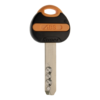Recently fitted a replacement euro cylinder for someone, key design as per image below (not my keys.) First time I've had experience of this key type. You need to be very precise to get it inserted, even when it's the right way up you sometimes think it isn't. The person using the key is elderly and finding it a bit difficult.
The keys are chamfered on the longer flat edges however the end profile of the key is nearly completely squared off and I reckon this isn't helping matters.
Could I chamfer a little bit from each of the short edges with a view to aiding insertion, or will this likely render the key useless? See below.


The keys are chamfered on the longer flat edges however the end profile of the key is nearly completely squared off and I reckon this isn't helping matters.
Could I chamfer a little bit from each of the short edges with a view to aiding insertion, or will this likely render the key useless? See below.



